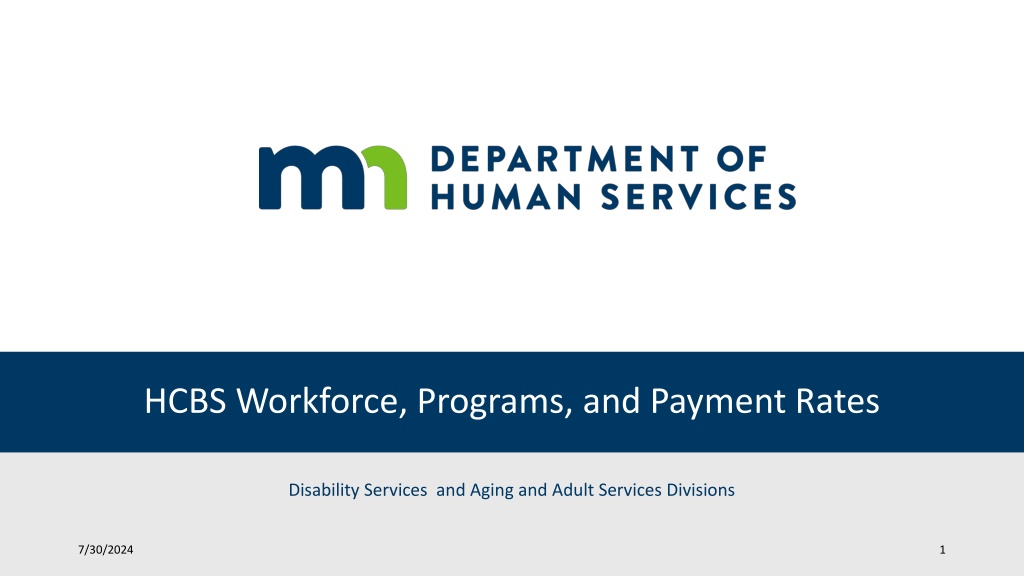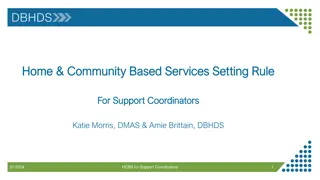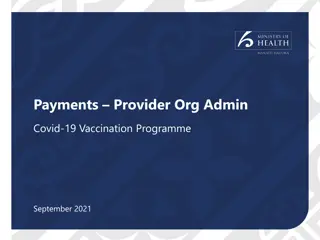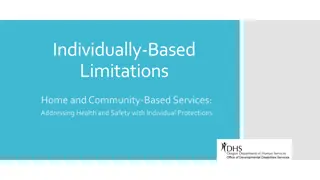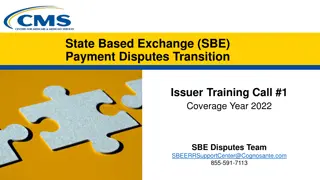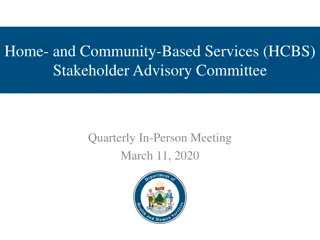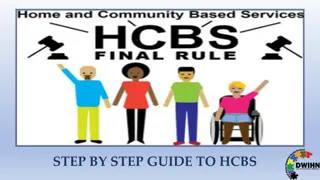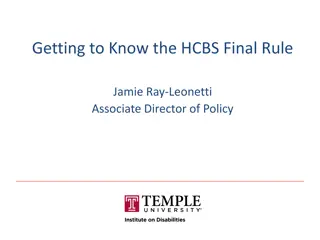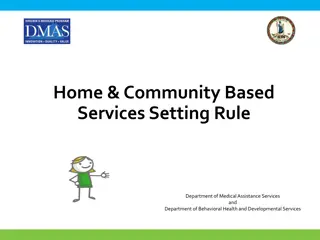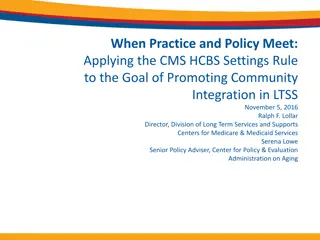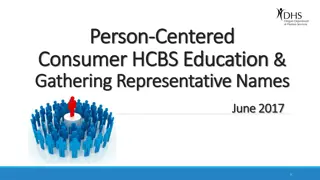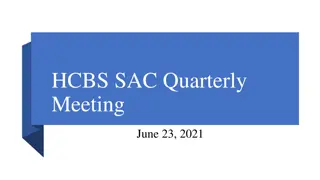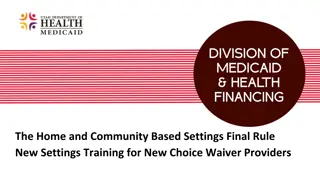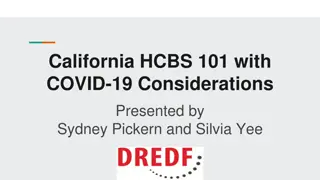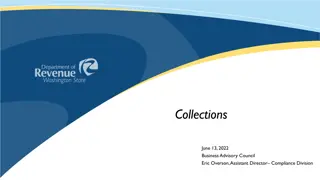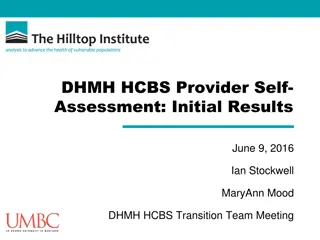Understanding Home and Community-Based Services (HCBS) Programs and Payment Rates
Explore the world of Home and Community-Based Services (HCBS), including methods of rate-setting, challenges faced by the workforce, and policy solutions. Learn about the cost-effective alternatives to institutional care that enable individuals with disabilities and older adults to live independently and participate in community life. Delve into MA state plan services, HCBS waivers, and more in Minnesota's comprehensive benefit set.
Download Presentation

Please find below an Image/Link to download the presentation.
The content on the website is provided AS IS for your information and personal use only. It may not be sold, licensed, or shared on other websites without obtaining consent from the author. Download presentation by click this link. If you encounter any issues during the download, it is possible that the publisher has removed the file from their server.
E N D
Presentation Transcript
HCBS Workforce, Programs, and Payment Rates Disability Services and Aging and Adult Services Divisions 7/30/2024 1
Agenda Overview of Home & Community-Based Services (HCBS) Methods of Rate-Setting for HCBS Challenges Facing the Direct Support Professional Workforce Data Evaluations and Policy Solutions 7/30/2024 2
Home and Community Based Services (HCBS) Programs The term Long Term Services and Supports refers to the array of services available to support people with disabilities and older adults, including nursing facilities, intermediate care facilities for people with developmental disabilities and hospitals. Home and community based services are a subset of Long Term Services and Supports. They are cost effective alternatives to institutional care, and enable people with disabilities and older adults to live, work and participate in community life. They include: Medical Assistance (MA) state plan home and community based services Medical Assistance (MA) home and community-based service waivers Federally funded services, but not through Medical Assistance State and local funded supports and services 7/30/2024 4
Average Cost of Long Term Services & Supports Average Monthly Cost of Long Term Services & Supports for Older Adults and People with Disabilities (Jan. 2017) $8,000 $6,000 $4,000 $2,000 $- Overall Home and Community-Based Services Institutional Services Home and Community-Based Services include the disability waivers, Elderly Waiver, Alternative Care, State Plan Home Care, and the Consumer Support Grant. Institutional Services include nursing facilities, intermediate care facilities for persons with developmental disabilities (ICF/DD), and Rule 5 facilities. 7/30/2024 Optional Tagline Goes Here | mn.gov/dhs 5
MA state plan home and community based services Minnesota offers a comprehensive benefit set. People meeting financial and functional need eligibility criteria may receive the service. These services include: Personal Care Assistance (PCA) Home Care Nursing Home Health Aide These state plan services have set rates that do not vary by person. 7/30/2024 6
MA HCBS Waivers Home and Community Based Services through MA waiver programs provide additional services that support a person when state plan services alone do not meet a person s assessed needs. Minnesota provides five HCBS waivers: Elderly Waiver (EW) Developmental Disabilities (DD) Waiver Community Access for Disability Inclusion (CADI) Waiver Community Alternative Care (CAC) Waiver Brain Injury (BI) Waiver Alternative Care program provides HCBS to older adults. Alternative Care is for people with low income and assets who are not eligible for Medical Assistance. 7/30/2024 7
Eligibility by Age Elderly Waiver and Alternative Care Disability Waivers (BI, CAC, CADI, DD) State Plan HCBS Services, including Personal Care Assistance (PCA) 7/30/2024 8
HCBS Programs (SFY 2018) Program Average Monthly People Served Total Annual Cost of Services Disability Waivers 45,186 $2.48 billion Elderly Waiver & Alternative Care 27,813 $466 million State Plan Home Care PCA: 36,323 Home Health Agencies: 2,819 Home Care Nursing: 750 $1.18 billion Source: Nov. 2018 Forecast Disability Waivers includes the Brain Injury (BI), Community Alternative Care (CAC), Community Alternatives for Disability Inclusion (CADI), and Developmental Disability (DD) Waivers Elderly Waiver includes both fee-for-service and managed care State Plan Home Care includes PCA paid through fee-for-service and managed care. Home Health Agency and Home Care Nursing includes fee-for-service information. There are some additional people who receive services, such as skilled nursing visits, paid through managed care. 7/30/2024 mn.gov/dhs 9
Waiver Rate-Setting: Overview Statute outlines rate setting methodologies for HCBS waivers. They are based on the cost of providing services. Direct support professional wages are the basis for the rate. Direct support wages in the disability waiver rate formulas vary from $12.27 to $22.38/hour. Direct support wages in the aging formulas vary from $12.84 to $18.87. Other cost components in the rate formulas include benefits, supervision, program support, training, utilization, and administrative costs. 7/30/2024 11
Waiver Rate-Setting: Overview Rate formula cost components are prospective and based on multiple evaluations and on going research of the cost of providing waiver services: Evaluation of compensation, including wages, benefits and other factors Evaluation of non-wage cost factors A provider wage and cost survey supported the use of BLS codes as an accurate reflection of the average wages paid to direct support professionals. For detailed finding, please see the January 2019 legislative report titled: Evaluation of Rate Methodology for Services Provided under Elderly Waiver and Related Programs 7/30/2024 12
Disability Waiver Rate System The Disability Waiver Rate System (DWRS) prospectively set rates for the DD, CADI, CAC, and BI waivers. Under DWRS, each service has a formula ( framework ) that sets rates based on cost components outlined in state law. Includes an inflationary update, once every five years. 7/30/2024 13
Disability Waiver Rate System Some DWRS frameworks establish a rate for all recipients. They are what we call unit based services , and include independent living services, personal support, and employment services. Other DWRS frameworks require service-specific information based on a person s assessed needs to calculate a rate, which may include: Direct staffing ratio Staffing hours Nursing hours Type of staffing (in-person, remote) When additional information is needed, it is manually entered by lead agencies in an electronic rate calculation form that was developed by DHS and is available to counties/tribes as part of the MnCHOICES Support Plan application. 7/30/2024 14
DWRS input example As an example, this is the information required to calculate a daily rate for Day Training & Habilitation: Direct staffing ratio Deaf or hard of hearing customization Licensed Practical Nurse hours per day Registered Nurse hours per day County of residence 7/30/2024 15
Example of adding information into the formula 7/30/2024 16
DWRS banding When the legislature passed DWRS, it created a multi-year transition period that would phase-in DWRS rates for services using 2013 as a base. This phase-in transition is referred to as banding. Current law ends the banding period on December 31 2020. Minnesota currently only has federal authority to continue banding through December 31 2019. At the end of the banding period, all disability waiver rates will be set using the framework formulas. This will take a year to complete the final transition since rates will be updated at the time of the waiver recipient s annual review and service authorizations for the next year are completed. 7/30/2024 17
Elderly Waiver and Aging Rate-Setting The 2017 legislature authorized rate-setting methods for many HCBS services for older adults The basic elements of the methods align with the Disability Waiver Rate System The aging rate-setting methods were evaluated for the first time in 2018 DHS recommendations are in the January 2019 legislative report: Evaluation of Rate Methodology for Services Provided under Elderly Waiver and Related Programs As directed by statute, the aging rate-setting methods make up 10% of the final rate. 90% of the rate is based on rates paid on June 30, 2017. The aging rate-setting methods currently do not include inflationary updates 1/14/2019 18
Elderly Waiver and Aging Rate-Setting Due to partial implementation, rates for many HCBS services for older adults are lower than the new rate-setting methods produce Full implementation of the rate-setting methods would make more dollars available to providers to pay direct support professionals 1/1/2019 Rates Full Implementation Rates Percent Difference Examples Unit Adult Day Chore Companion Home Delivered Meals 15 Minutes 15 Minutes 15 Minutes 1 Meal $3.45 $4.15 $2.57 $6.81 $4.32 $7.50 $6.36 $8.17 25.2% 80.6% 147.4% 20.0% 1/14/2019 19
MA State plan Personal Care Assistance (PCA) rates State plan PCA services do not use framework formulas to set rates. Currently, the rate for a 15 minute unit of service is $4.35 (or $17.40/hour) and does not include inflationary updates. 72.5% of the rate must go to direct support professional wages and benefits. PCA rates have been adjusted periodically through legislation. Evaluations have shown that PCAs are the lowest paid workers in the HCBS workforce. 7/30/2024 20
Direct Support Professional Data To fully understand workforce challenges and identify data-informed solutions, more information is needed about the direct support professional workforce. This workforce includes those who directly deliver PCA and waiver services. DHS uses one-time, voluntary surveys and other data about compensation as funding is available to inform program rate-setting. Wage assumptions built into waiver rate formulas are based on previous research. However, DHS does not currently have funding or authority to regularly collect data on direct support professional wages and benefits to determine changes in the market or if investments are effective in addressing workforce issues. 7/30/2024 22
The Direct Support Professional Workforce Supporting peoples community lives requires a dedicated and valued workforce across Minnesota. Having well-trained direct support professionals (DSPs) leads to better outcomes and more consistent care. Access to services and supports are challenged by workforce factors such as a demographic change resulting in fewer people to do the work, low pay, lack of career advancement, and variable service payments across programs. DEED data indicates Minnesota currently has about 135,000 DSPs and will need an additional 68,000 in coming years to meet the anticipated demand. 7/30/2024 23
Job Vacancies Job Vacancies in MN, 4th Quarter BLS Code 39-9021 Personal Care Aides, includes most direct support professionals 7,000 6,000 5,000 4,000 3,000 2,000 1,000 - 2001 2002 2003 2004 2005 2006 2007 2008 2009 2010 2011 2012 2013 2014 2015 2016 2017 7/30/2024 24
Direct Support Professional Compensation Nationally, approximately 45 percent of DSPs live in households earning less than 200 percent of the federal poverty level. In 2015, over half of direct support professionals in the United States relied on some form of public assistance. The same study found approximately 40 percent of homecare workers relied on public health care coverage, most often Medicaid. 7/30/2024 25
Direct Support Professional Wages Typical wages for direct support professionals are relatively low. Many variables affect the wages and benefits paid to DSPs. Regional business environment Border cities Local minimum wage ordinances 7/30/2024 26
Rate effect on direct support professional compensation Program payment rates directly effect compensation, including wages and benefits. These are governed by legislative action. Many direct support professionals perform similar tasks, yet there are services, such as PCA that do not have a formula to inform rate changes. Some people require highly-specialized supports, but the current service system does not sufficiently incentivize investment in specialized experience and career lattices to ensure people with significant needs have workers prepared to support them. In order to break from past low compensation, one strategy is to insert a competitive workforce factor into rate formulas. 7/30/2024 27
Average 15-minute unit rates Avg Unit Rate (FY18) $14.00 $12.00 $10.00 $8.00 $6.00 $4.00 $2.00 $0.00 CADI, ILS 15-min Ind. Employment Support, 15-min DD, Adult Corp. SLS, 15- min EW, ICLS 15-min EW, Homemaker, 15-min PCA, 15-min 7/30/2024 28
Comparative Wage Analysis DHS performed a 2018 analysis that used Bureau of Labor Statistics (BLS) data to compare DSP wages with other occupations with similar education, experience, and training requirements. Of all the 76 occupations with similar requirements, the weighted average of other occupations was 17.31 percent higher than the weighted average DSP wage for HCBS services. The difference between current framework wages and those of other occupations are referred to as a competitive workforce factor. 7/30/2024 30
Comparing Bureau of Labor Statistics wages in Minnesota BLS occupational title Total number of Minnesota Minnesota hourly mean wage workers Personal care aides 67,420 $11.83 Customer service representatives 56,610 $18.51 Office clerks, general 53,070 $17.00 Home health aides 25,200 $12.69 Bus drivers, school or special client 15,720 $15.97 7/30/2024 31
University of Minnesota workforce survey In 2018, DHS used on time grant funds to contract with the University of Minnesota to conduct a one-time workforce survey of Minnesota HCBS providers. The project was supported and endorsed by ARRM, MOHR, Care Providers of Minnesota, Leading Age Minnesota, Minnesota Homecare Association, The Arc Minnesota, Association of People Supporting Employment First, and Minnesota Families and Advocates Coalition. This survey was focused on broader workforce issues and examined: Wages of DSPs, supervisors, and other provider staff Benefits of these job categories Retention rates All values provided are interim. DHS expects final results and analysis available shortly. 7/30/2024 32
Hourly wages by region Region Average Full-time Wage Average Part-time Wage Twin Cities Metro $13.09 $12.81 Greater Minnesota-Regional Centers $12.99 $11.55 Greater Minnesota-Rural $12.75 $12.29 Minnesota-Total $12.90 $12.33 *Preliminary findings 7/30/2024 33
Hourly wages by service type Service Type Average Wage Rate (per hour)* Home Health Aide $13.67 $21.96 - 32.04 PCA $11.75 $17.40 Waiver Day Services $12.34 $39.24 Waiver Residential Services $13.16 $34.80 Waiver Unit-based Services $12.76 $27.54 - 53.85 *Does not include DWRS banded values **Preliminary findings 7/30/2024 34
Other interim survey findings 57% of providers offer health insurance to full-time DSP 52% of providers offers paid time-off to full-time DSP 4% of reported revenues were paid out as overtime costs Average turnover was 38.8% over one 12-month period Providers who completed the survey employ 18,332 DSP, and serve 17,941 people with disabilities and older adults 7/30/2024 35
Rate evaluation DHS regularly conducts rate evaluations on HCBS programs 2017 legislation directed DHS to conduct an evaluation of aging programs to include: Evaluation of base wages Evaluation of non-wage cost factors Statute guides evaluation of the DWRS frameworks, which are reviewed with stakeholders. 1/7/2019 36
Whats next There are a number of options that could be used to increase direct support professional job satisfaction. In 2018, the Cross-Agency Direct Care and Support Workforce Shortage Working Group submitted recommendations to the Olmstead Subcabinet to address the workforce shortage. The Working Group s top recommendation was to increase DSP wages and/or benefits in order to enhance job satisfaction and retention. 7/30/2024 37
DHS Recommendations Establish a rate-setting method for PCA services Fully implement the Elderly Waiver rate-setting methods As directed by statute, the aging rate-setting methods make up 10% of the final rate, leading to rates that are lower than recommendations Full implementation of the rate methods would make more dollars available to providers to pay direct support professionals Add a competitive workforce factor to HCBS service rates This would gradually raise wage components in service rates to align with occupations that have similar education and training requirements. Additional data monitoring, or surveying, may be required to know whether the competitive workforce factor or other investments have the intended effect of increasing DSP recruitment and retention. 7/30/2024 38
Addressing the challenge The workforce shortage is a national challenge requiring many approaches and collaboration among stakeholders. There are policy and fiscal options available to the Legislature and DHS to address the workforce shortage. DHS is committed to working with partners throughout Minnesota to implement strategies so people can get the services they need. 7/30/2024 39
